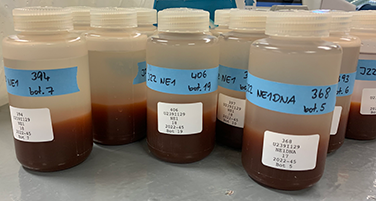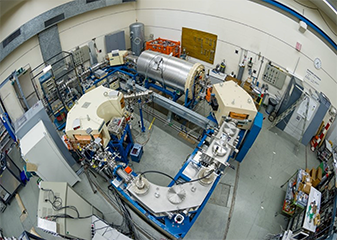Ashley Arroyo
September 30, 2022
Annabel Payne (PhD student) and Anne-Marie Wefing (postdoc) are from ETH Zürich taking water samples to analyze dissolved isotopes in the Canada Basin while aboard the Louis S. St-Laurent. As you may remember from dispatch 7, one of the sub-projects that Annabel is sampling for involves using Hafnium and Neodymium isotopes to study the origin of surface water in the Canada Basin. In addition to this, there are two other ongoing projects that Annabel and Anne-Marie are collaboratively taking water samples for. Today at the 11:00am science meeting, which is a daily meeting to discuss weather, research, and other updates, Annabel and Anne-Marie gave us a brief presentation of their sub-projects!
Another important study includes sampling for radioactive uranium and iodine, which are released from nuclear reprocessing plants from France and the United Kingdom. Since uranium and iodine were released in annually reported volumes since the 1970’s, they can be used as water mass tracers with a point-like source, making them incredibly powerful tools for the oceanographic community to understand where waters have come from and how long they have been circulating in the Arctic. Annabel and Anne-Marie are using the uranium and iodine isotopes to track Atlantic-sourced water in the Arctic Ocean’s Canada Basin. Atlantic water brings heat and nutrients into the Arctic Ocean as it flows through Fram Strait and the Barents Sea opening. With climate change, the amount of Atlantic water flowing into the Arctic along with the heat it brings is increasing, which could have implications to sea ice and ecosystems.
Finally, sampling for Argon 39 and Carbon 14 isotopes helps to understand how the deep waters of the Arctic Ocean are ventilated (i.e., how much time has passed since these waters were last in contact with the atmosphere). Deep waters in the Canada Basin tend to circulate for a very long time (hundreds of years!). Argon 39 and Carbon 14 isotopes can tell us where these waters are coming from and how long they hang around because they both have known half-lives (i.e., the amount of time it takes for the isotope to decay to half its concentration. The use of Argon 39 is relatively new and has not been used in previous studies due to the difficulty in measuring it, so this is an exploratory study to test its applicability to ventilation studies in the deep ocean. All the samples the Annabel and Anne-Marie are taking aboard the Louis will be processed and analyzed back in Switzerland, at a lab in ETH Zürich. We are all looking forward to hearing the results of these studies!
As to what the science crew has been up to, everyone has been busy at work sampling, running samples, and deploying instruments. Even though everyone is working hard, we are still making time for fun, in the form of cribbage tournaments, bingo, darts, puzzles, and running on the treadmill!

